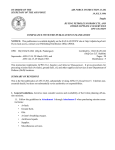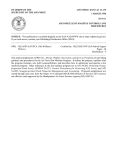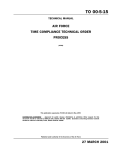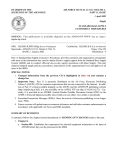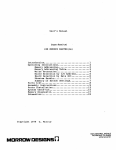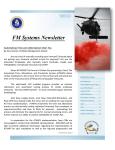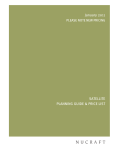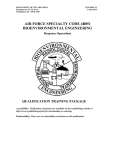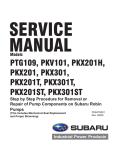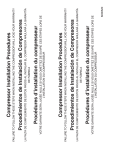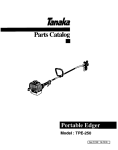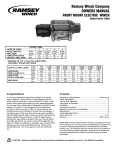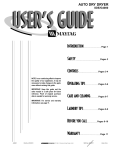Download afoshstd91-66
Transcript
Template modified: BY ORDER OF THE SECRETARY OF THE AIR FORCE 27 May 1997 14:30 AIR FORCE OCCUPATIONAL SAFETY AND HEALTH STANDARD 91-66 1 OCTOBER 1997 Safety GENERAL INDUSTRIAL OPERATIONS NOTICE: This publication is available digitally on the SAF/AAD WWW site at: http://afpubs.hq.af.mil. If you lack access, contact your Publishing Distribution Office (PDO). OPR: HQ AFSC/SEGS (SMSgt Pennie Hardesty) Supersedes AFOSH Standard 91-66, 18 January 1995 Certified by: HQ AFSC/SEG (Colonel Robert W. Scott) Pages: 19 Distribution: F The criteria in this standard are the Air Force’s minimum safety, fire prevention, and occupational health requirements for general industrial operations. Major commands (MAJCOM), direct reporting units (DRU), and field operating agencies (FOA) may supplement this standard when additional or more stringent safety, fire prevention, and health criteria are required. Refer to Air Force Instruction (AFI) 91-301, Air Force Occupational and Environmental Safety, Fire Protection, and Health (AFOSH) Program, for instructions on processing supplements or variances. Report conflicts in guidance between this standard, federal standards, or other Air Force directives through MAJCOM, DRU, or FOA ground safety offices to Headquarters Air Force Safety Center, Ground Safety Division, Safety Engineering and Standards Branch (HQ AFSC/SEGS), 9700 Avenue G, SE, Suite 222, Kirtland AFB NM 87117-5670. This standard applies to all US Air Force industrial operations including all US Air Force Reserve personnel and when Air National Guard personnel are on federal service. It is intended to minimize or eliminate safety, fire, and health hazards to personnel and property associated with these operations. This standard does NOT apply to contractors working on Air Force installations, including contractors who use government-furnished equipment and facilities. They are responsible for the safety and health of their personnel. Contractors may choose to follow all or parts of this standard, but it is not mandatory for the protection of the employees. This standard implements those portions of Occupational Safety and Health Administration (OSHA) standards and other national safety consensus standards listed in the ‘references’ section of Attachment 1. SUMMARY OF REVISIONS Administrative changes and updated references have been made to update this standard to electronic format. Paragraph 1.1.2. has been changed to require specific wording on scrap and combustible waste containers. Paragraphs 1.6.6. and 1.7.3.4. have been changed to require installation bioenvironmental engineering (BE) and (or) ground safety staffs to evaluate and establish the need for ventilation or personal protection equipment (PPE). Safety procedures to be followed during thunderstorms (paragraph 1.16) are added. NOTE: AFOSH 127-series standards are being converted to 91-series standards and the 161-series to 48-series standards. However, not all standards have been converted as of the effective date of this standard. To help you locate these documents, references to AFOSH standards are stated in the updated series and standard number, with the outgoing series and standard number stated as “formerly designated as” in the ‘references’ section of Attachment 1. A | indicates revisions from previous edition. 2 Chapter 1 SAFE PRACTICES IN SHOPS, OFFICES, AND GROUNDS MAINTENANCE OPERATIONS 1.1. General Housekeeping: 1.1.1. Floors and Walking Surfaces. Keep areas, where personnel walk and work, free of potential tripping hazards such as tools, electrical cords, air lines, and packaging materials. Clean up fluid spills as soon as possible and post warnings until cleanup is complete. 1.1.2. Scraps and Combustible Waste. Provide sufficient metal or noncombustible containers with self-closing lids for the disposal of combustible wastes, soiled rags, and other flammable materials. These containers must be marked according to the requirements in AFI 32-7042, Solid and Hazardous Waste Compliance, and AFOSH Standard 48-21, Hazard Communication. Dispose of contents according to approved hazardous waste disposal procedures. Contact the installation environmental management office for guidance. Use properly marked, covered metal containers for storing clean rags. 1.1.3. Packing Supplies. Store excelsior, straw, shredded paper, and other packing materials in isolated fire-resistant buildings. Store small supplies of packing materials, which are kept in shops for immediate use, in metal or noncombustible covered containers. Remove protruding nails, brads, and staples from crates, cases, packing boxes, casks, boards, and lumber to prevent injury to personnel. 1.1.4. Electric Buffing Machines. Ensure electric buffing machines are equipped with “deadman” control switches. Unless the machines are double insulated, ensure electrical cords include three-prong plugs to ensure positive ground. 1.1.5. Walls and Ceilings. Keep projections from walls to a minimum. Maintain ceilings in good repair and free of loose plaster. 1.1.6. Stacking Materials. Stack materials so they may be easily reached but do not project into aisles or passageways. Use crossties, separators, or dunnage to prevent objects from falling or toppling over. When materials are stacked to a height of less than 15 feet, maintain an 18-inch clearance below ceiling fire-sprinkler deflectors, joists, rafters, beams and roof trusses. If the stack is over 15 feet in height increase the clearance to 36 inches. Position all stacks of materials to ensure an 18-inch clearance around light or heating fixtures or follow manufacturer’s instructions, regardless of height. See Air Force Manual (AFMAN) 23-210, Joint Service Manual (JSM) For Storage and Materials Handling, for additional information. 1.1.7. Lighting Fixtures. Ensure fluorescent light fixtures, that are not designed with self-locking tubes, are provided with shields, clamps, or other methods to keep the tubes from inadvertently falling out of the fixture. 1.2. Office Safety Practices : 1.2.1. Safety Checklists. Supervisors, with assistance from the installation ground safety and the BE staffs, should develop office safety checklists. The National Safety Council’s (NSC) Accident Prevention Manual for Industrial Operations (Administration and Programs) and the Supervisor’s Safety Manual, normally maintained by the installation ground safety staff, provide guidelines to assist the supervisor. 3 1.2.2. Computers and Other Office Machines. Ensure electrical power cords and installation wiring are not strung across floors, but are placed in conduits, covered by approved metal and (or) rubber strips, or suspended from overhead. 1.2.3. Office Ergonomics. When circumstances indicate problems may exist due to ergonomically related illnesses or injuries or from worker complaints, the functional manager or supervisor will contact the installation Director of Base Medical Services (DBMS) or the installation ground safety staff to arrange for a survey of office work stations and accomplish a job safety analysis. After required corrective actions are completed, inform the DBMS or ground safety staff of any new operations, jobs, or procedures so ergonomics principles can be applied. 1.3. Battery Shops and Rooms: 1.3.1. General: 1.3.1.1. Battery shops are primarily used to recharge equipment batteries or to charge new batteries. Personnel who operate these facilities work with hazardous materials and may potentially be exposed to toxic or corrosive chemicals and explosive gases. Ensure these personnel are trained in specific technical and safety procedures outlined in this section. All persons, who do not routinely perform duties in a battery shop and have a need to visit the shop, will receive a safety briefing before entry. 1.3.1.2. If batteries are installed in a permanent location, the requirements of Articles 480 and 500 of National Fire Protection Agency (NFPA) 70, The National Electrical Code (NEC), will apply. 1.3.1.3. Ventilate battery shops or rooms to prevent an accumulation of gases. AFOSH Standard 48-2, Industrial Ventilation, provides guidance necessary to install general ventilation and hooded ventilation over charging batteries. 1.3.1.4. Personnel who perform tasks in battery shops will take the following precautions to prevent the mixing of incompatible materials: 1.3.1.4.1. Ensure nickel-cadmium and silver-zinc batteries are serviced in an area isolated from lead-acid batteries. 1.3.1.4.2. When acids and potassium hydroxide are handled in the same shop, ensure the specific equipment for the two types of materials are separated and labeled. 1.3.1.5. Do not position or store tools or other metal objects where they may fall onto batteries. 1.3.1.6. Workers will wear protective equipment while servicing batteries. This equipment will include, as a minimum, rubber apron and cuffed gauntlet gloves, acid resistant safety shoes or rubber knee length boots with safety cap, face shields (wrap around), and goggles (chemical resistant) that protect from the sides and the front. Workers will not wear finger rings, watches, and other jewelry that may come in contact with batteries. If metal rimmed eye glasses are worn, secure them by some method to prevent them from inadvertently falling on the batteries. 1.3.1.7. When mechanical or other materials handling equipment are used to move batteries, personnel will take precautions to prevent short circuiting between battery posts. 1.3.1.8. Ignition sources are not allowed in battery charging rooms. Post appropriate warning signs at the entrances to the shops or rooms to warn personnel of the hazards. 4 1.3.1.9. Shop supervisors will ensure fire extinguishers of the appropriate types are placed in battery shops or rooms. Coordinate with the base fire department for guidance. 1.3.1.10. Keep vent caps in place when charging batteries to prevent electrolyte spray. Remove vent caps only if required by technical data on specific batteries. Do not disassemble a lead-acid battery when taken directly from a charger or when the battery has been discharged under load. (In either case, the battery may be outgassing and presents an explosion potential.) Do not permit excessive charging of lead-acid batteries, due to the generation of hydrogen gas. 1.3.1.11. Take the following precautions when mixing electrolyte acids: 1.3.1.11.1. Pour acid into water gradually. Never pour water into acid! (The heat of dilution will cause the water to boil and splatter.) 1.3.1.11.2. Do not pour acid into metal containers or stir solution with metal utensils. 1.3.1.11.3. Use a carboy tilter or siphon to handle electrolyte. 1.3.1.11.4. Use running water to wash down spilled electrolyte. Ensure drains are equipped with an approved holding tank, or if not, capped to prevent the release of hazardous materials into the common sewer system. Consult with the installation environmental manager regarding the proper disposal of used batteries and (or) acid. 1.3.1.11.5. If electrolyte is splashed on the skin or in the eyes, flush with water for at least 15 minutes and then seek medical attention immediately. See paragraph 1.3.1.13. 1.3.1.12. When taking specific gravity reading, cover the open end of the hydrometer with an acid resistant material while moving from cell to cell to avoid splashing of electrolyte. 1.3.1.13. The need for an emergency eyewash and shower in areas where batteries are being stored, serviced, charged, or used is determined by the level of risk of being exposed to hazardous materials. The local functional manager will evaluate the need for portable eyewash bottles to be carried in vehicles when performing hazardous tasks at remote sites. See AFOSH Standard 91-32, Emergency Shower and Eyewash Units, for additional guidance. NOTE: Requests for emergency showers and (or) eyewashes will be routed through the installation ground safety and BE staffs, to determine the need for installation of units. 1.3.2. Charging 0perations for Powered Industrial Trucks. This operation will comply with paragraphs 1.3.1.1., 1.3.1.5. through 1.3.1.7., 1.3.1.11., and 1.3.1.12. of this standard. See AFOSH Standard 9l-46, Material Handling and Storage Equipment, and Occupational Safety and Health Administration (OSHA) 29 Code of Federal Regulations (CFR) 1910.178, Powered Industrial Trucks, for additional requirements. 1.3.3. Batteries and Battery Charging on Construction Sites. These operations will comply with paragraphs 1.3.1.1, 1.3.1.3, 1.3.1.5 through 1.3.1.7, 1.3.1.10, 1.3.1.11, 1.3.1.12, and 1.3.1.13. Also refer to OSHA 29 CFR 1926.441, Batteries and Battery Charging, for additional requirements for construction sites. 1.4. Laundries and Dry Cleaning Operations . There are only a few facilities in the Air Force. MAJCOMs should ensure that installations having these facilities comply with appropriate requirements contained in OSHA 29 CFR 1910.264, Laundry Machinery and Operations, OSHA-adopted NFPA 32, Dry-cleaning Plants, and AFOSH Standards 91-31, Personal Protective Equipment, and 48-2. 5 1.5. Photographic Laboratory Safety : 1.5.1. General: 1.5.1.1. Maintain Material Safety Data Sheets (MSDS) on all chemicals and ensure they are available to all workers. Ensure MSDS are delivered with any new chemicals or products. Train all personnel to know and understand the hazards which are present in all job tasks. See AFOSH Standards 91-68, Chemical Safety, and 48-21 for guidance and requirements. 1.5.1.2. Maintain good housekeeping practices in all areas, especially in areas where chemicals are handled. 1.5.1.3. Ensure appropriate hand cleaners are available for workers where hazardous chemicals are handled. Wash hands with the cleaner and rinse thoroughly immediately after handling hazardous chemicals, even though no known contact has occurred. 1.5.1.4. Wash rubber gloves with hand cleaner and rinse well with water after each use and before removing the gloves. 1.5.1.5. Maintain required respirators according to the manufacturer’s instructions and as trained by the local bioenvironmental engineer (BEE). See AFOSH Standard 48-1, Respiratory Protection Program, for additional guidance. 1.5.1.6. Ensure adequate ventilation is installed in processing rooms. See AFOSH Standard 48-2 for guidance. 1.5.1.7. Brief outside maintenance personnel and visitors on the importance of avoiding skin contact with chemicals or work surfaces contaminated with chemical residue. 1.5.1.8. Store all chemicals in cool, dry, dark areas. Maintain separate storage areas for chemicals that are known to react violently with each other. For example, do not store potassium permanganate near glycerine. Follow the MSDSs of the various chemicals. 1.5.1.9. Store chemicals on shelves strong enough to support their loads. Design each shelf with coping or ledges to prevent containers and equipment from extending over the edges or inadvertently falling. Chemical storage areas or rooms must be sloped and drained into an approved holding tank or be capable of containing a spill. 1.5.1.10. Keep all corrosive chemicals in thick walled glass containers protected by wooden frames or boxes. If the capacity of the container is 5 gallons or more, support the frame by a sturdy wooden or metal cradle that is pivoted or hinged for ease in dispensing. 1.5.1.11. Ignition sources are not allowed in photographic laboratories. Post appropriate signs at entrances. 1.5.1.12. Install electrical equipment according to the guidance contained in the NEC. 1.5.2. Personal Protective Equipment (PPE). The functional manager or supervisor will evaluate PPE requirements for the photographic laboratory. When requested, the BE or installation ground safety staff will provide assistance in the selection of equipment. See AFOSH Standard 91-31 for requirements. 1.5.3. Eyewash and Emergency Shower Facilities. Supervisors or functional managers will ensure facilities are available so workers who are exposed to hazardous chemicals can flush their eyes and 6 bodies. Assistance may be obtained from the ground safety or BE staff to determine the type of equipment required. See AFOSH Standard 91-32. 1.5.4. Electronic Flash Equipment. Supervisors will ensure workers are trained to be aware of the potential risks associated with this equipment. Electronic flash equipment is designed to work at a high potential, in most cases 450 to 4000 volts. After discharge, the condensers carry a heavy charge of electricity which must be depleted or “bled off” before any repair work can be attempted. There may be an additional danger of sparking of the contact points in the power packs. Precautions listed below are to be followed when servicing and operating this equipment, whether it is in the laboratory, aircraft, or at other locations. 1.5.4.1. Only qualified personnel will service high voltage electronic flash equipment. 1.5.4.2. This unit will not be operated in potentially hazardous atmospheres containing explosive vapors, dusts, or fumes above the Lower Explosive Limit (LEL). 1.5.4.3. A unit will not be charged for firing unless the flashlamp is installed and the complete assembly is ready for use. If the assembly was not fired after it was charged, the flashlamp will not be removed for at least an hour. 1.5.4.4. The power cord will be disconnected from the power pack before removing the lamp or touching the metal part of the lamp socket. 1.5.4.5. Before the batteries are removed, workers will ensure the assembly has been discharged and that the charging switch has been changed from the “charge” position. 1.5.4.6. Stored energy from electronic flash units can be lethal. Dependent upon the rate of discharge, this amount of current could severely burn or cause fatal injury to a worker. Workers will follow the manufacturer’s instruction for the proper waiting time for any stored charge to be depleted before removing a broken tube from strobe equipment. NOTE: Newer products have a misfire alarm with a reset feature that bleeds the energy off. Follow manufacturer’s instructions for safe operations. 1.6. Fiberglass Repair and Fabrication . Resins used in laminating are normally low pressure laminating types. These resins are normally supplied as a liquid varying in viscosity from a water-like consistency to a thick syrup and are available commercially from several manufacturers. Cure or polymerization of polyester resins is aided by the use of a catalyst, usually benzoyl peroxide, and in most cases, at a relatively high temperature. If room temperature cure is to be used, an accelerator or promoter will be added to the resin before the peroxide catalyst is added to the mixture. The procedures and materials for catalyzing and curing resins shall be according to the manufacturer’s instruction sheet when specific instructions are not available in Air Force technical data. Contact with some of these resin formulations may cause nasal or skin irritation. Personnel handling resins will wash with soap and water at frequent intervals. Solvents may cause irritations when used to remove resins from the skin. If personnel exhibit signs or symptoms, they should be referred to the installation medical service. Also see AFOSH Standard 91-10, Civil Engineering, Chapter 4. 1.6.1. Hazard Communication. Supervisors will ensure all workers performing fiberglass repair and fabrication tasks are trained in hazard communication and MSDS are available for all toxic products used in the processes. See AFOSH Standards 48-21 and 48-8, Controlling Exposures to Hazardous Materials, for additional guidance. 7 1.6.2. Hazardous Waste. Supervisors will coordinate with installation environmental management to establish procedures for disposing of hazardous wastes. (Reference AFMAN 322-4004, Emergency Resonse Operations, Attachment 3, Response Guidance for Advanced Aerospace Materials/Composites.) 1.6.3. Storage Requirements. Store resins in closed metal containers in a cool place at a temperature not to exceed 80 degrees Fahrenheit (F) (27 degrees Celsius [C]). Where specified on the container, store epoxy resins in an approved refrigerator. As catalysts, promoters, and solvents are very reactive, store them in the original airtight containers, isolated from one another in a cool place. Do not mix the catalyst and promoter together because they are explosively reactive as a mixture. Workers will always mix the promoter with the resin first and then add the catalyst to the mixture. Do not store catalyzed resin in an airtight container or an unvented and (or) unapproved refrigerator. Catalyze only enough resin for immediate use. 1.6.4. Sanding Operations. Sanding operations on glass cloth reinforced laminates generate a fine dust that may cause eye and skin irritations, or if inhaled, may affect the respiratory system. Consult with the installation bioenvironmental engineering officials for guidance on eye, skin, and respiratory protection requirements. 1.6.5. Eyewash and Emergency Showers. Due to the potential for eye and skin contact with resins, the installation of eyewash and emergency shower facilities should be considered for fiberglass repair shops. Coordinate with installation ground safety and BE officials to determine the type and location. 1.6.6. Ventilation Requirements. Ventilation for fiberglass repair and fabrication shops must be based upon the recommendations of the installation BEE, according to AFOSH Standard 48-2. 1.7. Electrical Safety in Shops : 1.7.1. Electrical Repairs. Qualified workers may perform repairs on equipment that has been deenergized and locked out and tagged according to guidance found in AFOSH Standard 91-45, Hazardous Energy Control and Mishap Prevention Signs and Tags. In some circumstances, shop technicians may work on low voltage control, power, and lighting circuits while energized for the purpose of testing, calibrating, troubleshooting, making minor repairs, and replacement of fuses and circuit breakers. If the voltage exceeds 300 volts, a safety observer will be present. These tasks will be performed only when authorized by applicable Technical Orders (TO), manufacturer’s, or other approved procedures and directives. In all other cases where repairs to energized circuits or equipment are required, the work will be accomplished by qualified electricians. Install electrical equipment according to the guidance contained in the NEC. 1.7.2. Electrical Cords: 1.7.2.1. Electrical extension cords will not be used as a substitute for fixed wiring, attached to building surfaces, or ran through doorways or under carpets, or through holes in walls, ceilings, or floors. Extension cords shall not be spliced, stapled, tacked, coiled, or placed where they may be damaged or create a hazard. Cords will be inspected by the user to ensure they are of the proper size and rating and are not damaged. Damaged cords will be replaced or repaired. 1.7.2.2. Flexible cords with portable equipment will be secured to the machine by an underwriter’s knot or by other device approved for the purpose to prevent putting strain on conductors and connections. Grounded devices will have a three-prong plug unless the equipment is double insulated; then a two prong plug is acceptable. 8 1.7.2.3. Cords used with heating appliances, such as electric irons, will be covered with flame-proof insulating material. 1.7.2.4. Extension cords used with portable tools and equipment will be designed with three-prong plugs. EXCEPTIONS: Double insulated tools and low amp devices, such as wall clocks, pencil sharpeners, tape recorders, etchers, and lamps, may be used with a two-prong plug. The minimum amperage rating of the extension cord will be at least equal to, but not less than, the amperage rating of the item being powered from the cord. Plugs and sockets will be designed according to the NEC. 1.7.3. Additional Electrical Equipment Requirements: 1.7.3.1. Close rack doors at all times except as necessary to accomplish authorized repairs. 1.7.3.2. Operators will open and close all equipment switches quickly and positively. Ensure contact between brushes and commutators or slip rings is not broken while equipment is operating. 1.7.3.3. Operators or other shop personnel will not unplug equipment with components operating on high voltage unless technical publications authorize the removal of an electronic component such as a subassembly or module. 1.7.3.4. Use only approved solvents for cleaning electronics equipment. Provide adequate ventilation and, when using solvents, wear approved PPE when required by installation ground safety or BE officials. Use of compressed air (less than 30 pounds per square inch [psi]) for cleaning electrical equipment should be considered only as a last resort. Vacuuming is considered an effective cleaning method. 1.7.3.5. Technicians will not use lead pencils, screw drivers, or other unapproved tools to make radio frequency energy tests on any piece of electronic equipment, as serious burns can result from this practice. 1.7.3.6. Personnel should not hold meters in their hand while performing measurements on energized circuits or equipment. When it is necessary to handhold meters or metering cables, use gloves or other effective PPE. The holder must stand on or be in contact with dry surfaces. 1.7.3.7. Workers will keep workbenches clean at all times. When voltage is applied to equipment being repaired or tested, personnel will ensure tools not essential to the test and other equipment are removed from the bench. Ground metal workbenches used for repairing and testing of electronic equipment to a low resistance ground. Use stools made of wood, fiberglass, or other nonconducting materials when working on electrical or electronic equipment. NOTE: For electrostatic discharge control procedures, refer to TO 00-25-234, General Shop Practice Requirements for Repair - Electrical Equipment. 1.7.3.8. Supervisors will plainly mark all electrical fuse, switch, and circuit-breaker boxes with correct voltage. Mark fuse and switch boxes to identify what they control unless their purpose is evident. 1.7.3.9. Purchase rubber insulating floor matting with reference to TO 00-25-234, TO 00-25-232, Control and Use of Insulated Matting for High Voltage Applications, and Military Manual (Mil-M) 15562, Matting or Sheet, Floor Covering, Insulating for High Voltage Application, to ensure that approved products are used. 9 1.7.3.10. Supervisors will establish procedures requiring all accessories that are to be used with electronic and electrical equipment are serviceable and safe to use. Establish procedures to eliminate or control all hazard potentials to a safe acceptable level. 1.7.4. Emergency Equipment (Electrical Safety Boards). Functional managers may desire to have emergency equipment available at each operating location where maintenance is performed on energized high voltage circuits. High voltage is defined as 600 volts, nominal or more. Variations in the equipment will depend on local conditions and additional items may be added as determined by the commander or functional manager. The equipment may be displayed on a board, stored in a cabinet, or available in a portable kit. The emergency equipment will be situated in a conspicuous and prominent location at each site, well marked, and readily accessible to personnel. If an electrical safety board is used, recommend the dimensions be 4 feet by 4 feet by one-half inch. Color coding is not mandatory; however, the recommended color is a dark green background with white letters and border. In each case, the color of lettering should be conspicuous against the darker background. The following items may be included in an emergency equipment kit or board: 1.7.4.1. The safety operations instructions or procedures for the site. 1.7.4.2. Cardiopulmonary resuscitation (CPR) instructions. 1.7.4.3. Emergency phone numbers and building number. 1.7.4.4. First aid kit approved by the base medical services. This item is required if work is remote from the nearest medical facility. 1.7.4.5. Nonconductive cane or hook with an insulated handle. 1.7.4.6. Insulated fuse pullers (where required). 1.7.4.7. Flashlight with nonmetallic case in operating condition (especially where emergency lights are not installed). 1.7.4.8. Grounding stick (shorting stick). 1.7.4.9. Snake bite kit (remote work sites). 1.7.4.10. Wool blanket. 1.7.4.11. Insulating blanket. 1.7.4.12. Portable emergency signs constructed of nonconductive materials. AF Visual Aids (AFVA) 91-303, DANGER—DO NOT ENERGIZE—PERSON WORKING ON ANTENNA; 91-304, DANGER—DO NOT ENERGIZE—WORK IN PROGRESS ON EQUIPMENT; 91-305, DANGER—INTERLOCKS DISABLED; and 91-306, DANGER— HIGH VOLTAGE, are available through the local publications distribution office. See AFOSH Standard 91-45 for information on safety signs and tags. 1.7.4.13. CPR face mask with disposable mouthpiece. 1.7.4.14. Disposable gloves, which are impervious (leakproof) to body fluids, for first aid use. 1.8. Grounds Lawn Care and Mowing Safety. All personnel shall observe all safety precautions in this standard and those recommended by the manufacturer of the equipment. Always read the owner’s manual before operating the equipment. See TO 47C-1-1, Safety Instructions for Lawn Care Equipment, for additional guidance. 10 1.8.1. Powered Push Mowers. Before beginning the mowing operation, the operator shall clear people from the area to be mowed and inspect for foreign objects, raised sprinkler heads, holes, soft ground, obstructions, or any other condition that has the potential to impact the safety of the operation. Personnel operating this equipment should never pull the mower backwards while the engine is running because the safety guard on the back may cause the mower to lift off the ground, subjecting personnel to serious injury. Always mow across the face of a steep slope and keep firm footing at all times. Stay clear of the front of self-propelled mowers during and after starting. Control the mower by hand pressure on the handle, not by foot pressure on the housing. Do not attempt to clean grass from the chute when the mower is running. Disconnect the spark plug or if electrical, the power, when cleaning, repairing, or inspecting the mower. 1.8.2. Powered Mowers of the Walk-Behind Riding Rotary, Converted Sulky, and Reel Power Lawnmowers. These mowers shall meet the design specifications noted in OSHA Standards 29 CFR 1910.243, Guarding of Portable Powered Tools. For example: “Deadman controls shall automatically interrupt power to a drive when the operator’s actuating force is removed, and may operate in any direction to disengage the drive.” 1.8.3. Edgers. Check to make sure the guard is in place. Never use the edger when people are in line with the blade. Use proper PPE. Always disconnect power when inspecting or repairing the edger. 1.8.4. Personal Protective Equipment (PPE): 1.8.4.1. Foot Protection. Safety-toe shoes or metal toe guards will be worn when operating powered push mowers or edgers. When using mowers equipped with an installed rear drag plate or edgers with nylon filament line cutters and guidance in paragraphs 1.8.1. and 3. are followed, the use of safety-toe shoes or metal toe guards is optional. In all instances, personnel operating this equipment will wear shoes of sturdy construction. Open toed sandals, tennis shoes constructed of cloth or canvas, etc., are not appropriate for wear during mowing tasks. 1.8.4.2. Eye Protection. Use suitable eye protection (safety glasses, goggles, or face shields or a combination) when operating powered edgers or “weed eaters.” When mower operators are exposed to flying rocks, dirt, or other hazards, they will wear appropriate eye protection. 1.8.4.3. Hearing Protection. If hazardous noise levels are produced by the equipment being operated, workers will wear hearing protection. Coordinate with the installation BE staff for guidance. If equipment is identified as producing hazardous noise levels, place a decal or stenciled warning in view of the operator stating: “WARNING—THIS MACHINE CREATES HAZARDOUS NOISE LEVELS. EAR PLUGS OR MUFFS SHALL BE WORN.” See AFOSH Standard 48-19, Hazardous Noise Program, for additional guidance. 1.9. Nondestructive Inspection Laboratories . Refer to AFOSH Standard 91-110, Nondestructive Inspection and Oil Analysis Program. 1.10. Aircraft Flight Line and Ground Operations . Refer to AFOSH Standard 91-100, Aircraft Flight Line - Ground Operations and Activities. 1.11. Electrical Facilities and Equipment . Refer to AFOSH Standard 91-10, Civil Engineering. 1.12. Vehicle Maintenance Shops . Refer to AFOSH Standard 91-20, Vehicle Maintenance Shops. 11 1.13. Materials Handling and Storage . Refer to AFOSH Standard 91-46, Material Handling and Storage Equipment. 1.14. Fire Protection and Prevention . Refer to AFOSH Standard 91-56, Fire Protection and Prevention.. 1.15. Railroad Operations . Refer to TOs 45-1-5, Railroad Safety Operations, and 00-20D-1, Railroad Equipment Maintenance, Inspection, and Recordkeeping. 1.16. Adverse Weather Conditions : 1.16.1. The base weather station (BWS) is responsible for making the initial notification to predetermined support agencies of adverse weather conditions. Adverse weather conditions include: strong surface winds, heavy rain, freezing precipitation and thunderstorms (i.e., frequent dangerous lightning, and damaging winds, heavy rain and hail). 1.16.1.1. General lightning safety for all AF activities and operations: 1.16.1.1.1. Whenever lightning is detected or observed within the immediate vicinity of any activity or operation the following precautions should be taken: Do not go out of doors or remain out unless it is absolutely necessary. Seek shelter as follows: • Dwellings or other buildings that are protected against lightning; • Protected underground shelters; • Large metal framed buildings; • Enclosed aircraft, automobiles, buses, and other vehicles with metal tops and bodies; • Streets that may be shielded by nearby buildings. 1.16.1.1.2. Certain locations are extremely hazardous during thunderstorms and should be avoided: • Hilltops and ridges; • Areas on top of buildings; • Open fields, athletic fields, golf courses; • Parking lots, tennis courts; • Swimming pools, lakes, and seashores; • Near wire fences, clotheslines, overhead wires, and railroad tracks; • Under isolated trees; • Near electrical appliances, telephones, plumbing fixtures, and metal or electrically conductive objects. 1.16.2. Each Air Force installation will develop a local procedure to ensure that key personnel and agencies involved in high weather risk activities and operations are notified according to the base weather support plan. Normally, these agencies are those having aircraft, petroleum/oil/lubricant (POL) facilities, open air work and recreational activities, and underground utilities work. Key personnel, in turn, will advise all on-duty supervisors to take proper precautions and timely actions. 12 1.16.3. Each installation will employ a lightning safety program with a two-tiered notification system to minimize personnel exposure to lightning hazards: 1.16.3.1. A Lightning Watch is in effect 30 minutes prior to thunderstorms being within 5 nautical mile (nm) radius of any predetermined location or activity as forecast by the BWS. NOTE: Lightning is a direct product of a thunderstorm. During a Lightning Watch accomplish the following: • Operations or activities may continue; however, all personnel must be prepared to implement Lightning Warning procedures without delay. • Be alert for any lightning activity, to include audible thunder, and advise supervisory personnel of any observations. 1.16.3.2. A Lightning Warning is in effect whenever any lightning is occurring within 5 nm radius of the predetermined locations and activities. Personnel in affected locations or engaged in affected activities will take the following actions: • Cease all outside activity and seek shelter. Recommended locations that provide safe shelter and locations to avoid are listed in paragraph 1.16.1.1. • If lightning does not occur within 5 nm at the valid (forecast) time of the Lightning Watch, BWS will reassess the Lightning Watch and amend as needed. Lightning warnings will be canceled when the thunderstorms have passed beyond the 5 nm radius of the location or activity. A Lightning Watch will not be canceled if there is potential for more thunderstorms within 30 min. All aircraft fuel service maintenance activities (including liquid oxygen (LOX) servicing) will cease whenever a Lightning Warning is in effect. Automatic service stations will be placed in the manual operation mode. EXCEPTIONS: Commercial and Department of Defense (DoD) pipeline receipts, issues from military service stations or base exchange (BX) service station, vehicle movements (including refuelers), and pipeline transfers (including bulk storage). 13 Chapter 2 JEWELRY SAFETY 2.1. Finger Rings: 2.1.1. Mishap statistics over the past 10 years have revealed that the loss of portions of fingers due to the ring catching on some object is one of the most frequent causes of lost-time permanent partial injuries. Because of the potential for serious injury, finger rings will not be worn by personnel engaged in the following activities: (This restriction is also extended to personnel who may be assigned to these tasks on an infrequent basis.) NOTE: This prohibition applies only to personnel actually performing the work and is not intended for administrative and support personnel assigned to or visiting these areas. 2.1.1.1. Climbing, ascending, or descending activities where personnel could fall or jump from elevated surfaces account for the majority of injuries caused by the finger ring catching on an object. Some examples include personnel working on elevated surfaces; i.e., ladders, scaffolds, platforms, roofs, high reach vehicles, or descending from large vehicles such as refuelers, wreckers, sweepers, dump trucks, and stake bed trucks. The stake bed truck has been associated with a large majority of injuries caused by personnel jumping or descending from a large vehicle. 2.1.1.2. Most materials handling operations. Examples include warehousing, parts handling, operating equipment and packing and crating. 2.1.1.3. Work activities where personnel are exposed to moving machinery, rotating or revolving parts, or any task that could result in hands being caught in moving parts. 2.1.1.4. Work activities where personnel are exposed to energized electrical circuits. 2.1.2. It is not possible to list all situations or tasks where the wearing of rings have a high potential for injury. Supervisors should conduct job safety analysis to identify tasks where the wearing of finger rings should be restricted. Once tasks are identified, the supervisor will include this information as part of the initial employee safety briefing required by AFI 91-301. Installation ground safety may be contacted to provide assistance. Refer to AFI 91-202, The US Air Force Mishap Prevention Program, the NSC Accident Prevention Manual for Industrial Operations (Administration and Programs), and the NSC Supervisors’ Safety Manual for guidance on performing job safety analysis. WARNING: Placing tape over rings or wearing gloves on the hand with a ring does not provide protection or eliminate the requirement to remove finger rings. 2.2. Other Jewelry . Any jewelry that presents a potential for catching, snagging, pulling, and tearing should be evaluated and restricted from wear if necessary. Some types of jewelry that should be controlled under these job situations are watches, bracelets, and necklaces. Metal eyeglasses should be 14 secured by a band or cord to prevent them from falling into energized electrical circuits. Whenever possible, these types of jewelry should be removed before entering industrial work areas. FRANCIS C. GIDEON, JR., Maj General, USAF Chief of Safety 15 Attachment 1 GLOSSARY OF REFERENCES, ABBREVIATIONS, ACRONYMS, AND TERMS References Air Force Instruction (AFI) 32-7042, Solid and Hazardous Waste Compliance. AFI 91-202, The US Air Force Mishap Prevention Program. AFI 91-301, Air Force Occupational and Environmental Safety, Fire Protection, and Health (AFOSH) Program. Air Force Manual (AFMAN) 23-210, Joint Services Manual (JSM) For Storage and Materials Handling. AFMAN 24-306 (formerly designated as AFR 77-2), Manual for the Wheeled Vehicle Driver. AFMAN 32-4004, Emergency Response Operations, Attachment 3, Response Guidance for Advanced Aerospace Materials/Composites. Air Force Occupational Safety and Health (AFOSH) Standard 48-1, Respiratory Protection Program. AFOSH Standard 48-8, Controlling Exposure to Hazardous Materials. AFOSH Standard 48-19, Hazardous Noise Program. AFOSH Standard 48-21, Hazard Communication (formerly designated as AFOSH Standard 161-21). AFOSH Standard 91-10, Civil Engineering (formerly designated as AFOSH Standard 127-10). AFOSH Standard 91-20, Vehicle Maintenance Shops (formerly designated as AFOSH Standard 127-20). AFOSH Standard 91-31, Personal Protective Equipment (formerly designated as AFOSH Standard 127-31). AFOSH Standard 91-32, Emergency Shower and Eyewash Units (formerly designated as AFOSH Standard 127-32). AFOSH Standard 91-45, Hazardous Energy Control and Mishap Prevention Signs and Tags (formerly designated as AFOSH Standard 127-45). AFOSH Standard 91-46, Material Handling and Storage Equipment (formerly designated as AFOSH Standard 127-46). AFOSH Standard 91-56, Fire Protection and Prevention (formerly designated as AFOSH Standard 127-56). AFOSH Standard 91-68, Chemical Safety (formerly designated as AFOSH Standard 127-68). AFOSH Standard 91-100, Aircraft Flight Line - Ground Operations and Activities (formerly designated as AFOSH Standard 127-100). AFOSH Standard 91-110, Nondestructive Inspection and Oil Analysis Program (formerly designated as AFOSH Standard 127-110). AFOSH Standard 161-2, Industrial Ventilation. 16 Military Manual (Mil-M) 15562, Matting or Sheet, Floor Covering, Insulating for High Voltage Applications. National Fire Protection Association (NFPA) 32, Drycleaning Plants. NFPA 70, The National Electrical Code (NEC). National Safety Council’s (NSC) Accident Prevention Manual for Industrial Operations (Administration and Programs). NSC, Supervisor’s Safety Manual. Occupational Safety and Health Administration (OSHA) Standard 29 Code of Federal Regulations (CFR) 1910.178, Powered Industrial Trucks. OSHA Standard 29 CFR 1910.243, Guarding of Portable Powered Tools. OSHA Standard 29 CFR 1910.264, Laundry Machinery and Operations. OSHA Standard 29 CFR 1926.441, Batteries and Battery Charging. Technical Order (TO) 00-20D-1, Railroad Equipment Maintenance, Inspection, and Recordkeeping. TO 00-25-232, Control and Use of Insulating Matting for High Voltage Application. TO 00-25-234, General Shop Practice Requirements for Repair, Maintenance, and Tests of Electrical Equipment. TO 45-1-5, Railroad Safety Operations. TO 47C-1-1, Safety Instructions for Lawn Care Equipment. Abbreviations and Acronyms AFI—Air Force Instruction (new designation) AFM—Air Force Manual (obsolete designation) AFMAN—Air Force Manual (new designation) AFOSH—Air Force Occupational Safety and Health AFR—Air Force Regulation (obsolete designation) AFSC—Air Force Safety Center AFVA—Air Force Visual Aid BE—Bioenvironmental Engineering BEE—Bioenvironmental Engineer BX—Base Exchange BWS—Base Weather Station C—Celsius CFR—Code of Federal Regulations CPR—Cardiopulmonary Resuscitation 17 DBMS—Director of Base Medical Services DoD—Department of Defense DRU—Direct Reporting Unit F—Fahrenheit FOA—Field Operating Agency HQ—Headquarters JSM—Joint Service Manual LEL—Lower Explosion Limit LOX—Liquid Oxygen MAJCOM—Major Command Mil-M—Military Manual MSDS—Material Safety Data Sheets NEC—National Electrical Code NFPA—National Fire Protection Association nm—Nautical Mile NSC—National Safety Council OSHA—Occupational Safety and Health Administration PDO—Publishing Distribution Office POL—Petroleum/Oil/Libricant PPE—Personal Protective Equipment psi—Pounds Per Square Inch TO—Technical Order WWW—World-Wide Web Terms May—Indicates an acceptable or satisfactory method of accomplishment. Shall—Indicates a mandatory requirement. Should—Indicates a preferred method of accomplishment. Will—Is also used to indicate a mandatory requirement and in addition is used to express a declaration of intent, probability, or determination. 18 Attachment 2 CHECKLIST—GENERAL INDUSTRIAL OPERATIONS This is not an all-inclusive checklist. It simply highlights some critical items in this standard. Other requirements exist in the standard that are not included in the checklist. Where appropriate, MAJCOMs, DRUs, FOAs, local safety personnel, and supervisors will add to this checklist to include command or individual shop-unique requirements or situations. A2.1. Are the basic principles of good housekeeping in evidence? (Paragraph 1.1.) A2.2. Has an office safety checklist been developed? (Paragraph 1.2.) A2.3. Has an office ergonomic program been instituted? (Paragraph 1.2.3.) A2.4. Have battery shop personnel been trained in correct safety procedures? (Paragraph 1.3.1.) A2.5. Have the required articles of PPE been procured and made available to battery shop personnel? (Paragraph 1.3.1.6.) A2.6. Are appropriate eyewash and emergency shower facilities available in areas where batteries are stored, charged, serviced, or used? (Paragraph 1.3.1.13.) A2.7. Have photographic laboratory personnel been trained in the provisions of the Hazardous Communication Standard? (Paragraph 1.5.1.) A2.8. Have the required items of PPE been procured and made available to photographic laboratory personnel? (Paragraph 1.5.1.) A2.9. Are photographers trained on the potential hazards associated with electronic flash equipment? (Paragraph 1.5.4.) A2.10. Are personnel who work in fiberglass repair and fabrication shops trained on the properties of the hazardous chemicals used in the processes? (Paragraph 1.6.) A2.11. Are shop or office workers aware of and do they practice good electrical safety principals? (Paragraph 1.7.) A2.12. Are personnel, who are required to use mowers and edgers, trained on the safety precautions to take? (Paragraphs 1.8.1. through 1.8.3.) A2.13. Have the required PPE items been procured and made available to personnel who operate lawn care equipment? (Paragraph 1.8.) A2.14. Have personnel, who may be exposed to machinery, required to on- and off-load trucks, or work on elevated surfaces, been trained on the potential hazards of wearing jewelry during these tasks? (Chapter 2) 19




















